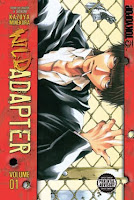 Creator: Kazuya Minekura
Creator: Kazuya Minekura
U.S. publisher: Tokyopop
ISBN: 9781598169782
Released: February 2007
Original release: 2001
I initially came across Kazuya Minekura’s manga series Wild Adapter while looking for manga with references to mahjong. Later on I learned that the series has some pretty heavy shōnen-ai overtones to it as well, which I was just fine with. So I picked up Wild Adapter, read it, and fell in love with the series. That was also when I belatedly realized that Minekura was also the creator of the popular Saiyuki and Saiyuki Reload manga. I was pretty happy when the Wild Adapter series was selected for the June 2011 Manga Moveable Feast. Wild Adapter is currently six volumes long, all of which have been published in English by Tokyopop, plus a few chapters that have been serialized in Japan for the seventh book. However, due to Minekura’s rather serious health concerns, Wild Adapter and many of her other ongoing series are currently on hiatus. The first volume of Wild Adapter was released in Japan in 2001 while the English edition was published in 2007.
Seventeen-year-old Makoto Kubota is a highly skilled mahjong player and a natural leader, catching the eye of the Izumo syndicate who recruit him to head their youths. The Tojou organization, a rival yakuza group, encroach even more than they have been on Izumo’s territory, trying to take advantage of the newcomer’s inexperience. But Kubota proves to be a dangerous and deadly adversary. When a mysterious new drug known as W.A. hits the streets, both the Izumo and Tojou groups are interested in gaining control of it and its distribution. The police, too, are investigating since a string of bizarre corpses seems to be connected to the drug. For Kubota, the search for W.A. and for more information about it becomes a personal vendetta when he is forced to confront the risks involved head on.
There are several interesting things about Minekura’s artwork in Wild Adapter. Although occasionally seen, very little tone and shading is used, instead black and white starkly contrast with each other. The pages themselves are also black instead of the usual white. This aesthetic decision lends itself to the darker aspects of the story and also emphasises the loneliness and disconnectedness of the characters as the panels are visually separated as well. Minekura is not afraid of silence, either. The technique is used to capture the passage of time but also helps to focus the reader on important dialogue and distinct moments in the individual panels. Minekura’s balance and pacing between dialogue and artwork is excellent. Her character designs, while similar to those in some of her other series, are easily distinguished from one another in Wild Adapter. Close attention is paid to accurate body structures. Although realistic, occasionally the figure work can be vaguely disconcerting.
The first volume of Wild Adapter serves as a prologue to the series as a whole. Tokito, one of the main characters, only makes a brief appearance. Instead, the first volume focuses on and introduces Kubota, the other protagonist, primarily as seen through the eyes of his second-in-command in the Izumo Youths, Komiya. Komiya doesn’t even like Kubota to begin with and is reluctant to serve under a rookie outsider but he comes to admire and even fear Kubota, developing a tremendous sense of devotion. This intimate camaraderie is extremely important to Kubota who keeps everyone at a distance. Even though the first volume of Wild Adapter focuses on Kubota, he still remains much of an enigma. Extraordinarily difficult to read, he is a mess of contradictions; at times he is almost innocent, sweet, and kind but in a moment he can become cruel, brutal, and vicious. As one character describes him, “He’s an odd boy, but an absolute pleasure.” Love him or hate him, Kubota’s intensity and charisma are critical to Wild Adapter.







